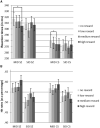Functional connectivity in a monetary and social incentive delay task in medicated patients with schizophrenia
- PMID: 37711426
- PMCID: PMC10498543
- DOI: 10.3389/fpsyt.2023.1200860
Functional connectivity in a monetary and social incentive delay task in medicated patients with schizophrenia
Abstract
Introduction: Numerous studies indicate impaired reward-related learning in individuals with schizophrenia, with various factors such as illness duration, medication, disease severity, and level of analysis (behavioral or neurophysiological data) potentially confounding the results. Patients with schizophrenia who are treated with second-generation antipsychotics have been found to have a less affected reward system. However, this finding does not explain the neural dysfunctions observed in previous studies. This study aimed to address the open question of whether the less impaired reward-related behavior is associated with unimpaired task-related functional connectivity or altered task-related functional connectivity.
Methods: The study included 23 participants diagnosed within the schizophrenia spectrum and 23 control participants matched in terms of age, sex, and education. Participants underwent an MRI while performing a monetary incentive delay task and a social incentive delay task. The collected data were analyzed in terms of behavior and functional connectivity.
Results: Both groups exhibited a main effect of reward type on behavioral performance, indicating faster reaction times in the social incentive delay task, but no main effect of reward level. Altered functional connectivity was observed in predictable brain regions within the patient group, depending on the chosen paradigm, but not when compared to healthy individuals.
Discussion: In addition to expected slower response times, patients with schizophrenia demonstrated similar response patterns to control participants at the behavioral level. The similarities in behavioral data may underlie different connectivity patterns. Our findings suggest that perturbations in reward processing do not necessarily imply disturbances in underlying connectivities. Consequently, we were able to demonstrate that patients with schizophrenia are indeed capable of exhibiting goal-directed, reward-responsive behavior, although there are differences depending on the type of reward.
Keywords: fMRI; functional connectivity; monetary incentive delay (MID) task; schizophrenia; social incentive delay (SID) task.
Copyright © 2023 Hanewald, Lockhofen, Sammer, Stingl, Gallhofer, Mulert and Iffland.
Conflict of interest statement
The authors declare that the research was conducted in the absence of any commercial or financial relationships that could be construed as a potential conflict of interest.
Figures




References
-
- Rademacher L, Schulte-Rüther M, Hanewald B, Lammertz S. Reward: From Basic Reinforcers to Anticipation of Social Cues. In: Current Topics in Behavioral Neurosciences. Berlin, Heidelberg: Springer Berlin Heidelberg. (2016). p. 1–15. - PubMed
LinkOut - more resources
Full Text Sources

